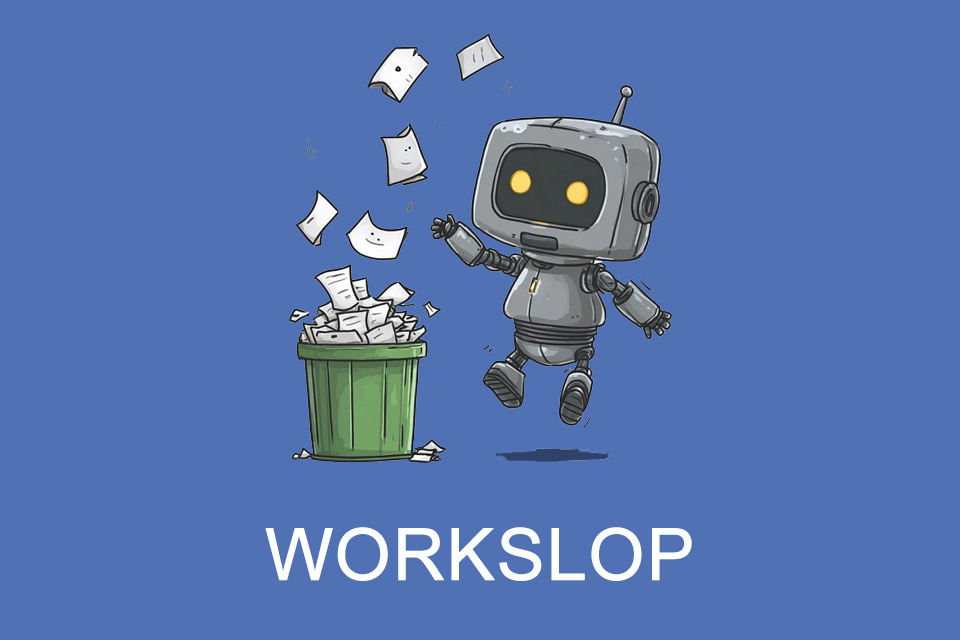What is Workslop?
Workslop: When work results shine but are of little use
At the touch of a button, AI generates a blog post that conveys a fictional example instead of real experiences. It generates an emotionally appealing social media post that does not show real feelings, but is only intended to attract attention. It produces thousands of lines of code, but has little understanding of architecture, clean code principles or security. A term has been coined for such situations: workslop.
Workslop describes work results that shine at first glance but, on closer inspection, are lacking in content, superficial or even useless. Instead of increasing productivity, they cause additional work due to checking, reworking or complete rewriting. [1]
From AI slop to bullshit jobs: the roots of workslop
The term workslop is relatively new and is composed of the English words work and slop (rubbish, mush, excess). It refers to work results that appear formally correct but have little substance in terms of content and are often created using AI.
Workslop has its roots in the term ‘AI slop’, which was coined in recent years to describe the flood of generic AI content on the internet. While AI slop mainly refers to mass-generated texts, images or videos of poor quality, workslop transfers the idea to the professional context: reports, blog posts, posts or code that shine but serve no real purpose.
This distinguishes Workslop from older terms such as ‘busywork’ (tasks that appear to keep people occupied but serve no real purpose) or ‘bullshit jobs’ (the administration of internal Excel reports that no one reads but whose absence is immediately noticeable because it is customary to produce them). [2] In contrast, workslop is not about meaningless activities per se, but about work results that superficially appear to be real achievements, but whose added value is low or non-existent.
Characteristics and causes of workslop
Workslop can be recognised by various characteristics:
- The work results are often formally correct, but weak in terms of content. A text may be linguistically well structured without providing new insights or developing a clear argument.
- Another typical characteristic is superficiality: for example, an AI generates a project analysis that presents colourful diagrams and impressive figures, but completely ignores key correlations or causes.
- Equally common are generic repetitions, i.e. statements that are constantly repeated in different formulations without adding any value.
- Finally, the biggest problem is the high amount of post-processing required: instead of making the work easier, the results have to be intensively checked, revised or even completely rewritten.
The causes of workslop are manifold. Speed often takes precedence over quality: content or code is produced under time pressure, without sufficient room for reflection and depth. Added to this is the unreflective use of AI, whose results are accepted without being checked. In many organisations, there is also a lack of clear quality criteria (what exactly constitutes a good text or clean code?), which leads to arbitrariness.
This phenomenon is exacerbated by incentive systems that reward quantity: those who deliver a lot of posts, lines of code or reports are considered productive, even if the substance is lacking.
Consequences and challenges of workslop
Workslop sounds harmless at first, after all, it refers to work results that appear professional at first glance. In practice, however, this leads to noticeable problems. A key risk is the loss of trust: if reports, analyses or code look clean but later turn out to be unusable, the credibility of authors, teams or even entire organisations declines.
Added to this is the sheer waste of time. Workslop must be reviewed, corrected or completely rewritten; an effort that reverses the supposed speed gains. This can be particularly serious in software projects: inadequately tested code not only leads to errors, but also to security gaps or systems that are difficult to maintain in the long term.
Another challenge lies in the flood of information. When presentations, reports or posts are produced in large quantities without delivering any real added value, there is an increased risk that important content will be lost in the mass. Employees and managers lose track of the big picture and begin to ignore information prematurely, even when it is relevant.
Finally, workslop has a cultural dimension: when quantity is systematically prioritised over quality, an environment is created in which genuine expertise, careful analysis and sustainable solutions remain undervalued. In the long term, this can weaken innovation and competitiveness.
Tips and countermeasures
Workslop can be avoided by consciously focusing on quality. The first step is to define clear standards. What constitutes a good report, a useful post or clean code in the organisation? Such criteria provide guidance and prevent formal smoothness from being confused with real added value.
Equally important is the attitude towards AI. It should be understood as a support, not a substitute for professional expertise. AI can provide ideas, suggest structures or speed up routines. However, the responsibility for substance, correctness and relevance remains with humans. Conscious curation, i.e. checking, supplementing and condensing the results, makes the difference between helpful and hindering.
The design of incentive systems also plays a role. Organisations that reward pure quantity unintentionally encourage the emergence of workslop. On the other hand, those that make quality visible and appreciate it, for example through measurable benefits, clean implementation or comprehensible effects, channel energy in the right direction.
And finally, it is worth pausing for thought. Less, but more thoughtful output is often more effective than a flood of superficial results. The crucial question is: does this work result really contribute to solving the problem? If the answer is yes, value is created. If not, workslop is a threat.
Impulse to discuss
How do you ensure that AI not only makes your work faster, but also better?
Here you can find additional information from our t2informatik Blog:



